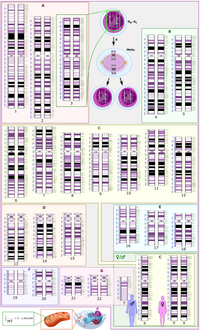
Photo from wikipedia
OBJECTIVE Genome sequencing (GS >30x) is beginning to be adopted as a comprehensive genome-wide test for the diagnosis of rare disease in the post-natal setting. Recent studies demonstrated the utility… Click to show full abstract
OBJECTIVE Genome sequencing (GS >30x) is beginning to be adopted as a comprehensive genome-wide test for the diagnosis of rare disease in the post-natal setting. Recent studies demonstrated the utility of exome sequencing (ES) in prenatal diagnosis, we investigate the potential benefits for GS to act as a comprehensive prenatal test for diagnosis of fetal abnormalities. METHODS We performed GS on a prospective cohort of 37 singleton fetuses with ultrasound-identified structural abnormalities undergoing invasive prenatal testing. GS was performed in parallel with standard diagnostic testing, and the prioritized variants were classified according to ACMG guidelines and reviewed by a panel of board-certified laboratory and clinical geneticists. RESULTS Diagnostic sequence variants were identified in 5 fetuses (14%), with pathogenic variants found in NIPBL, FOXF1, RERE, AMMECR1, and FLT4. A further 7 fetuses (19%) had variants of uncertain significance (VUS) that may explain the phenotypes. Importantly, GS also identified all pathogenic variants reported by clinical microarray (2 CNVs, 5%). CONCLUSION Prenatal GS offered diagnoses (sequence variants and CNVs) in 19% of fetuses with structural anomalies. GS has the potential of replacing multiple consecutive tests, including microarray, gene panels, and WES, to provide the most comprehensive analysis in a timely manner necessary for prenatal diagnosis. This article is protected by copyright. All rights reserved. What's already known about this topic? Current prenatal diagnostic protocol in Canada includes rapid aneuploidy detection (RAD) followed by microarray analysis. The diagnostic yield of Exome sequencing in fetuses with ultrasound abnormalities and negative results by RAD and CMA is 8.5 to 10%. However, the clinical utility of genome sequencing in prenatal settings is not established. What does this study add? This study demonstrates that RAD followed by genome sequencing has a diagnostic yield of ∼19% in fetuses with ultrasound abnormalities. Parental follow up testing to determine the inheritance of potentially pathogenic variants can further increase the diagnostic yield.
Journal Title: Prenatal diagnosis
Year Published: 2022
Link to full text (if available)
Share on Social Media: Sign Up to like & get
recommendations!